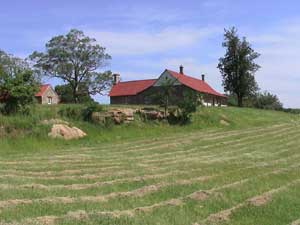RonRC
Well-Known Member
- Joined
- Sep 2, 2011
- Messages
- 1,313
- Reaction score
- 205
In the thread "For those who like reenactments..for real," in the Hunting forum, here, a wonderful South African site is listed. All those "Boers" (farmers) and Voortrekkers (Pioneers) in the modern photos made me think about the 1838 Blood River battle between the Zulu and the Voortrekkers in the area that would eventually become South Africa.

In 1838, the Voortrekkers were traveling north and east to get away from the hegemony of the British back in Cape Town. The were in wagons similar to our Conestoga wagons. Under attack, they would go into "lagger", the same as circling the wagons in our wild west. They were carrying smooth bore flintlocks. Some of the wealthier Voortrekkers had Doubles. They were all of large caliber: around .75 and bigger. Most were heavy full-stocked guns with long barrels. Some Brown Besses or similar probably also went along.
It seems that Dingane, the chief of the Zulus had an inclination to exterminate the Voortrekkers, so he sent between 10-20,000 Zulu warriors to attach the wagon train. There were just 450-475 Voortrekkers, including women and children, led by Andreas Pretorious.
The Voortrekkers put a belt of thorny acacia trees all around the circled wagons and left easily moved acacias here and there to let the horseman ride out from the circle and execute lightening strikes on the Zulu.
Some 20,000 or so Zulus versus 450 Voortrekkers. Who would you put your odds on? The Zulus attacked and the Voortrekker men fired! The women and children reloaded the long guns. The Zulus struggled to get through the acacias and were hit by volley after volley of lead balls. During a break in the action, some Voortrekker horsemen would ride out and strike the Zulu and come back in for protection.
It is estimated that the Zulu lost around 3000 casualties. They were thoroughly beaten and the blood that could be seen in the river resulted in the name of the battle.
There are some interesting parallels between our wagon trains to settle the West and the Voortrekkers move north to establish their own country. A big difference between the two migrations: the Voortrekkers took a much higher proportion of casualties in their migration. Therefore, there are very few of the Dutch family names that came down through history. Those Dutch names, Botha, Coetze, Pretorious, Visser, were augmented later when the French Huguenots were driven from France and Germany, with many settling in South Africa. I can't tell you how many people I know there by the names of du Plessis, du Toit. Even the last white president, de Klerk was originally du Clerque.
End of story, for now.
Ron

In 1838, the Voortrekkers were traveling north and east to get away from the hegemony of the British back in Cape Town. The were in wagons similar to our Conestoga wagons. Under attack, they would go into "lagger", the same as circling the wagons in our wild west. They were carrying smooth bore flintlocks. Some of the wealthier Voortrekkers had Doubles. They were all of large caliber: around .75 and bigger. Most were heavy full-stocked guns with long barrels. Some Brown Besses or similar probably also went along.
It seems that Dingane, the chief of the Zulus had an inclination to exterminate the Voortrekkers, so he sent between 10-20,000 Zulu warriors to attach the wagon train. There were just 450-475 Voortrekkers, including women and children, led by Andreas Pretorious.
The Voortrekkers put a belt of thorny acacia trees all around the circled wagons and left easily moved acacias here and there to let the horseman ride out from the circle and execute lightening strikes on the Zulu.
Some 20,000 or so Zulus versus 450 Voortrekkers. Who would you put your odds on? The Zulus attacked and the Voortrekker men fired! The women and children reloaded the long guns. The Zulus struggled to get through the acacias and were hit by volley after volley of lead balls. During a break in the action, some Voortrekker horsemen would ride out and strike the Zulu and come back in for protection.
It is estimated that the Zulu lost around 3000 casualties. They were thoroughly beaten and the blood that could be seen in the river resulted in the name of the battle.
There are some interesting parallels between our wagon trains to settle the West and the Voortrekkers move north to establish their own country. A big difference between the two migrations: the Voortrekkers took a much higher proportion of casualties in their migration. Therefore, there are very few of the Dutch family names that came down through history. Those Dutch names, Botha, Coetze, Pretorious, Visser, were augmented later when the French Huguenots were driven from France and Germany, with many settling in South Africa. I can't tell you how many people I know there by the names of du Plessis, du Toit. Even the last white president, de Klerk was originally du Clerque.
End of story, for now.
Ron






